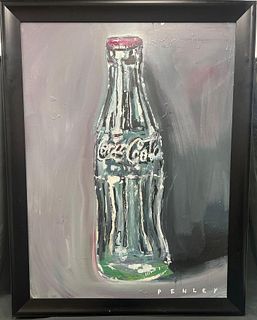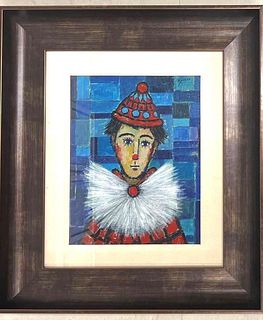Spanish school of the late seventeenth century. Circle of JUAN CARREÑO DE MIRANDA (Avilés, Asturias, 1614 - Madrid, 1685). "Portrait of Carlos II". Oi
Lot 24
About Seller
Setdart Auction House
Carrer Aragó 346
Barcelona
Spain
Setdart Subastas was born in 2004 and is currently the first online art auction in Spain with solidity, prestige and reliability guaranteed by our more than 60,000 users. Setdart has a young, dynamic and enterprising team ready to successfully manage the purchase and sale of art works through custom...Read more
Estimate:
EUR€5,000 - EUR€5,500
$5,376.34 - $5,913.98
Absentee vs Live bid
Two ways to bid:
- Leave a max absentee bid and the platform will bid on your behalf up to your maximum bid during the live auction.
- Bid live during the auction and your bids will be submitted real-time to the auctioneer.
Bid Increments
| Price | Bid Increment |
|---|---|
| EUR€0 | EUR€10 |
| EUR€200 | EUR€25 |
| EUR€500 | EUR€50 |
| EUR€1,000 | EUR€100 |
| EUR€3,000 | EUR€200 |
| EUR€5,000 | EUR€500 |
| EUR€10,000 | EUR€1,000 |
| EUR€20,000 | EUR€2,000 |
| EUR€50,000 | EUR€5,000 |
About Auction
By Setdart Auction House
Jun 1, 2021
Set Reminder
2021-06-01 09:45:00
2021-06-01 09:45:00
America/New_York
Bidsquare
Bidsquare : OLD MASTERS & SCULPTURE - Day 2
https://www.bidsquare.com/auctions/setdart-auction-house/old-masters-sculpture---day-2-6999
Setdart Auction House sofia@setdart.com
Setdart Auction House sofia@setdart.com
- Lot Description
Spanish school of the late seventeenth century. Circle of JUAN CARREÑO DE MIRANDA (Avilés, Asturias, 1614 - Madrid, 1685). "Portrait of Carlos II". Oil on canvas on its original canvas. Relined. Visible restorations on the back. The canvas is torn. Measurements: 152 x 110 cm. This portrait follows the model of the one painted around 1685 by Juan Carreño de Miranda, now in the Kunsthistorisches Museum in Vienna. Thus, we see the king full-length, dressed in rigorous black, wearing the golden fleece on his chest, leaning on a table with lion-shaped legs (an element that seeks to give solemnity to the figure of Charles II, called "The Bewitched" because of his weak musculature and infertility) and placed before a palatial background. Thus, our portrait follows faithfully, almost literally, the model established by Juan Carreño de Miranda, one of the main figures of the Spanish courtly pictorial panorama of the second half of the 17th century. Carreño defined a style that blends structural solidity with a remarkable taste for color, and which has as its sources both the works of preceding generations of local artists, including Velázquez, and those of some of the foreign painters who most influenced the development of the Madrid Baroque, among them Titian, Rubens and Van Dyck. Nephew and son-in-law of painters, he was trained in the workshops of Pedro de las Cuevas and Bartolomé Román, in Madrid, and his first dated work dates from 1646. From then on he was very active in the Madrid milieu, where he occupied a privileged position, holding important official positions. In fact, he was appointed painter to the king in 1669, and from then until his death he devoted himself mainly to portraying the royal family and various members of the court. However, throughout his career he tackled a remarkable variety of pictorial subjects, in different techniques. He was a notable draughtsman, cultivated the fresco and was the author of a prolific production of paintings on canvas, standing out as a religious painter as well as a portraitist. In this genre he had important clients such as the Cathedral of Toledo and important religious orders. Currently Carreño de Miranda is widely represented in the Prado Museum, as well as in the San Telmo Municipal Museum in San Sebastian, the Hermitage in St. Petersburg, the J. Paul Getty Museum in Los Angeles, the J. Paul Getty Museum in Los Angeles, the Hermitage in St. Petersburg, and the Museo del Prado in Madrid. Paul Getty in Los Angeles, the Kunsthistorisches in Vienna, the Louvre in Paris, the Metropolitan in New York, the Museum of Fine Arts in Boston, the Rijksmuseum in Amsterdam, the Museum of Fine Arts in Bilbao, the Courtauld Institute in London, the Lázaro Galdiano Museum, the Hispanic Society in New York, the Víctor Balaguer Library-Museum in Vilanova i la Geltrú and the El Greco House-Museum in Toledo, among many others.
- Shipping Info
-
In-house shipping available. Please inquire at admin@setdart.com.
-
- Buyer's Premium



 EUR
EUR CAD
CAD AUD
AUD GBP
GBP MXN
MXN HKD
HKD CNY
CNY MYR
MYR SEK
SEK SGD
SGD CHF
CHF THB
THB















